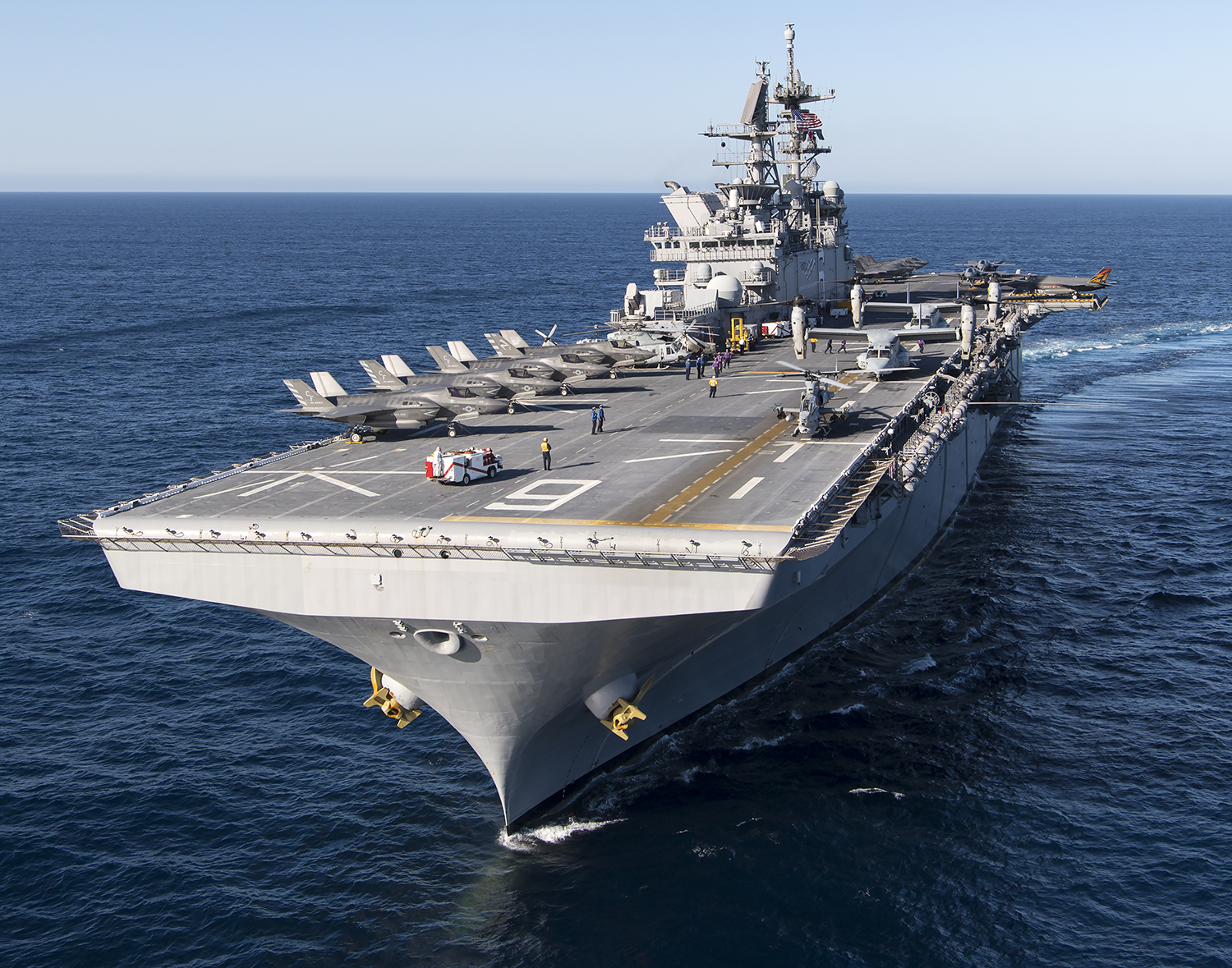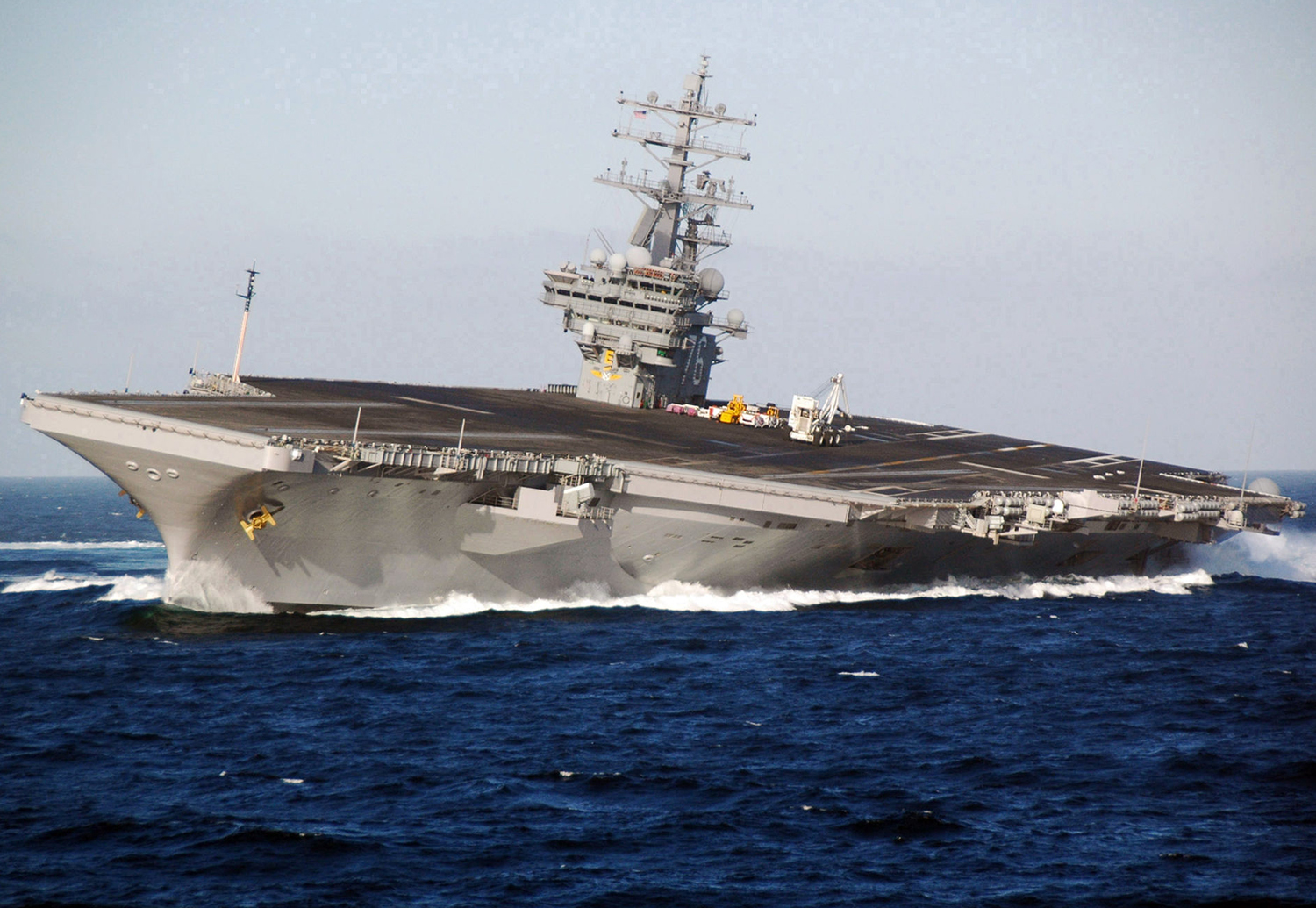The Senate Armed Services Committee’s version of the 2018 National Defense Authorization Act (NDAA) includes a sizable downstroke in what could turn into a program to finally build a smaller and less expensive aircraft carrier complement to America’s increasingly expensive supercarriers.
The provision includes $30M to come up with preliminary designs and cost options for such a ship, which then can be used to quantify the concept and how it would fit into the Navy’s overall strategy. The newest supercarrier design, the Ford class, cost upwards of $12B per ship. Meanwhile the Trump Administration has mandated a 12 supercarrier force.
Since the early retirement of the USS Enterprise (CVN-65), the Navy has struggled to meet tasking demands with the ten supercarriers it has in its inventory, and the USS Gerald R. Ford’s date of entry into operational service is a question mark due to technological issues and delays. With all these things in mind, the call for smaller, cheaper and more flexible aircraft carriers to add extra capacity to the Navy’s carrier force have grown louder in recent months.

This has been one of the key ideas I have talked about and pushed for over the years (like here and here), and it is a controversial topic to say the least. But clearly I am not alone when it comes to identifying a need to field smaller carriers and a more nimble aircraft carrier force than the Navy’s rigid, all supercarrier-based strategy that exists today. Most recently, I put this among the top of the list of things the Navy could do to revolutionize its war fighting capabilities in the piece
Seven Revolutionary Hardware Changes The Navy Should Make In The Trump Era, stating:
“The supercarrier still has its place in America’s arsenal, but naval aviation and naval warfare have changed since its genesis during the early decades of the Cold War. Since then, the supercarrier has become grossly expensive to construct, with the first of the new Ford class supercarrier costing roughly $13 billion, without research and development included. The second carrier in the class, the USS John F. Kennedy (CVN-79), is slated to cost roughly $11.5 billion.
At the same time, the carrier air wing has shrunk from nearly 90 aircraft during the 1980s down to around 65. In addition, precision guided munitions have allowed one strike fighter to reliably take out multiple targets on a single mission, instead of an entire air wing going after a single strategic target or small set of targets in a single alpha strike in single day. With all this in mind, the Navy’s demand to build ever larger aircraft carriers is counter productive and may be unsustainable in the long term.
Nuclear supercarriers are also extremely costly to operate, and their availability is based around a highly rigid and complex timetable. The recent carrier gap has proven just how little elasticity there is in America’s all supercarrier force. A mix of supercarriers and smaller carriers in the 65,000 ton class would allow for a more flexible overall aircraft carrier force, with greater strike capacity being able to be deployed on short notice….Under such a plan, supercarriers can also have their schedules better adjusted for concentrating on deployments and projecting power abroad, instead of executing more menial tasks like training new Naval Aviators or keeping up fleet aircrews’ carrier qualifications. The smaller carriers could be made available for these tasks, and would expand America’s ability to rapidly deploy naval power as need be along a far less rigid schedule.”
That roughly 65,000 ton displacement size seems to be a consistent “sweet spot” for a newer smaller aircraft carrier class, sometimes referred to as the “CVL,” with multiple studies identifying it as the right compromise between capability and cost. A ship that size would offer a Catapult Assisted Take-Off Barrier Arrested Recovery (CATOBAR) configuration like its bigger supercarrier brothers, but with two or three catapults instead of four. Size-wise, the notional design would be akin to something between the size of the USS Kitty Hawk on the high end the USS Midway on the lower end.

Sitting right in between those two iconic ships in terms of displacement, and a fresh, high-tech design that is readily available today, is the Royal Navy’s Queen Elizabeth class, which displace roughly 70,000 tons. As we have discussed before, the basic ship design can be adapted to accommodate a CATOBAR operations concept. The US could license the design, saving billions in development costs while lowering risk, and achieving commonality with the centerpiece of its closest ally’s navy. Even forward deploying a carrier to the UK could become an affordable option.

Setting perfect logic aside, if the Navy really ends up getting a new smaller carrier class, they will likely demand a custom design of their own. And there is nothing to say that the ship will end up being in the 65,000 ton displacement range. The Navy could just bypass a new design altogether and optimize the existing America class amphibious assault ship design for their needs—removing existing spaces for land vehicles, command and control areas used for amphibious operations, and compartments for embarked Marines, and adding more hangar space, weapons storage areas and jet fuel reserves in their place.
Going the America class route would require the Navy purchase the F-35B to be flown from these ships. The short-takeoff and vertical landing capable F-35B offers sizably less range and striking power than its CATOBAR capable F-35C brethren, but the convenience and economy of buying an all “off the shelf” smaller carrier solution, may trump these concerns.

As we discussed before, the USMC has already studied loading the decks of their America class amphibs with nearly two dozen F-35Bs in the “Lightning Carrier” configuration. But with the aforementioned modifications to the ship’s design, such a concept could be more easily supported. Still, generating very high-tempo sustained sortie rates using a short-takeoff and vertical landing aircraft is not ideal compared to what can be achieved with a CATOBAR configured carrier, and the Navy will likely resist opening the door to STOVL F-35B operations as it could endanger their CATOBAR tradition and the more capable, albeit also more complex and expensive carriers that go along with it.
Each America class ship has a unit cost of roughly $3.5B, and the billions in development costs for the new class have already been sunk. That means the Navy could buy roughly three modified America class carriers for the price of one Ford class supercarrier. But once again, it will have to outfit them with two squadrons of expensive F-35Bs to make the concept work.
It may be possible for designers to drastically modify the America class design to include a pair of catapults and an angled deck for CATOBAR operations, but depending on how much money this would save instead of just designing an all new CATOBAR carrier from scratch, such an endeavor may not be worthwhile. Other aspects of the ship, such as its powerplant, would also have to upgraded in order to overcome the increased mass as a result of such a major design modification.

Although the idea of the Navy building smaller carriers to complement their supercarrier force has been floating around for a long time, the timing may finally be right for such an initiative to blossom into a real program. The Trump Administration wants a 355 ship Navy, and replacing a couple of the planned Ford class ships with two or even three smaller carriers would help achieve this goal. Not just that, but the Navy is all about “distributing its fires” these days, and a hugely expensive supercarrier densely packed with a large portion of the Navy’s air armada doesn’t fit snugly into that strategy.
Beyond being key in assessing how much different levels of the smaller carrier concept will cost to build as well as what capability each design will bring to the table, this study will likely attempt to answer the question of what form of propulsion should be used to power such a concept. A conventional fueled carrier would be far less costly to procure and result in a more flexible force that can execute surge operations without long lead times as compared to a nuclear powered design.
But even with the winds blowing in the right direction for such a concept to take hold, the bigger question is will the Navy ever really buy into the idea of a conventionally fueled CATOBAR aircraft carrier? They hold onto their high-end nuclear weapon systems with a death grip—see their absolute unwillingness to field an advanced diesel-electric submarine as one glaringly stupid example.

Then again, the Royal Navy is now providing something of a proof of concept for a smaller carrier design—one that runs on conventional fuel—for the Navy to evaluate. Considering the USMC is slated to operate its F-35Bs aboard the HMS Queen Elizabeth, and that the US Navy and Royal Navy have incredibly tight ties, the Pentagon’s sea-going arm is going to get a close look at what a carrier roughly situated in size between the Ford class and the America class can accomplish. Not just in terms of what its air wing can do, but also in terms of operating such a ship with a crew that is just a fraction of the size of the ones found on a US Navy nuclear powered supercarrier.
If the Navy brass likes what it sees it could finally get onboard with the smaller, conventionally powered aircraft carrier concept, even at the expense of slowing the rate at which the service buys new nuclear supercarriers.
Now we’ll have to wait and see if this element within the Senate Armed Services Committee’s version of the 2018 NDAA makes it into law. If it does, we may be approaching a whole new and exciting phase in American carrier-borne naval aviation.
Contact the author: Tyler@thedrive.com
